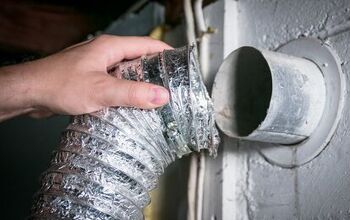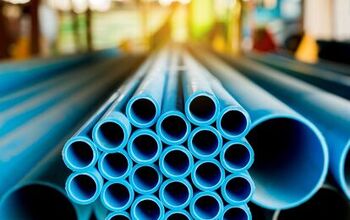Can You Use White PVC For Electrical Purposes? (Find Out Now!)

PVC or polyvinyl chloride pipe is one of the most versatile pipes on the market. People use PVC pipes for so many things, from crafts, utilities, water, electricity, and many more. There are three different PVC pipes, and each has its purpose. PVC is used for regular water and plumbing, while CPVC is used for hot water plumbing and PVC conduit is made for electricity.
The most noteworthy difference between regular PVC and electrical PVC is the pipe color. PVC pipes that are used for plumbing purposes are typically white and electrical conduit PVC is generally gray. This brings us to the question at hand: Can you use white PVC for electrical purposes?
You cannot use white PVC for electrical purposes and you cannot use gray electric conduit PVC for plumbing applications. Both PVC and PVC electrical conduit are specifically manufactured to serve distinct purposes, and therefore should not be interchanged. For example, electrical conduit PVC is tested and rated for UV exposure, while standard white PVC is not.
Do You Need to Hire an Electrician?
Get free, zero-commitment quotes from pro contractors near you.

The Different Types of PVC and What They Are Used For
Most people find the white PVC has the most uses, especially for those in arts and crafts. There is more to the picture, though most people may not realize unless they are into plumbing. As mentioned, all PVC pipes are labeled by color and are only used for their intentions.
Each section will cover those differences and their uses in the plumbing and electrical field. We can also mention the fun stuff people find helpful around the house with the white PVC pipe.
PVC Pipe
PVC pipes or not only versatile and the third most used plastic on the market. They are also recyclable for industrial, residential, and commercial use. It is not like other plastics because it does not take other limited resources and fossil fuels to produce.
In the plumbing sector, there are two different types of PVC pipes. One is white, and the other is black and only meant to be used for water and plumbing. Listed below are the differences.
1. White PVC Pipe
White PVC pipe is meant for regular water up to 140 degrees before deteriorating. It is also used for sewage pipes. They are not meant to take on the heat for long or extended periods, eliminating the question of electricity.
One of the most recognized factors of PVC pipe is it is used around different chemicals. The chemicals that would damage other plastics will not compromise the PVC pipe. PVC pipes replaced metal pipes decades ago, which polluted and corroded the drinking water systems.
A test was performed to see if the 57 percent chloride would be harmful to the environment. No evidence showed any damage to the earth’s environment if it was burned or discarded in the landfills. New plastics were then created, which took the form of CPVC pipes.
2. Black CPVC Pipe
CPVC stands for chlorinated polyvinyl chloride. These pipes are made to take extreme heat up to 200 degrees. The chlorine content in these pipes is as high as 74 percent, which is why CPVC can handle the heat.
Keep in mind how hot electricity is. It still exceeds the limitations of heat in CPVC. The hottest temperatures CPVC can handle would be directly from the hot water out of the hot water tank.
CPVC is more costly than PVC but still more effective than the traditional materials from the past. There are more uses in the commercial and industrial world. It is also favored among HVAC applications like ventilation and plumbing.
When it comes to chemical use, research is the critical factor to knowledge. PVC can handle certain chemicals CPVC cannot and vise versa. There is a chemical compatibility chart to look at when determining which pipe works best.
3. Conduit PVC Pipe
Conduit PVC pipe is labeled as grey color, and it is not pressure tested like regular PVC pipes for pressure. The chances of leaking are high if a conduit PVC pipe is used in plumbing. It is easy to tell it could never withstand water pressure by looking at the wall thickness.
Conduit PVC wall is much thinner than regular PVC and is more flexible. One thing to be aware of is Schedule 80 PVC pipe is used for plumbing but is also grey. They are not meant to be used for electrical conduits.
Conduit pipe is rated for UV exposure and can withstand outdoor weatherproofing applications. It is meant to handle exposure to the weather and UV rays so that electrical wires can get hooked up outdoors.
With extended timeframes of exposure to UV rays, standard white PVC pipe will not work for electrical purposes. Neither can be switched up for usage, but they are reliable and highly effective in their field.
Let’s also look at the heat on rooftops and direct sunlight where the white PVC will degrade over time. The last thing you want to do is keep having to change out the pipe. It will also expose the wire inside and degrade the wire even faster, leaving the copper exposed.
Working With All the PVC Pipes
Keeping everything separate is the way to go with the different pipes we have covered. Another question that arises deals with cutting the pipes. Many people wonder if places like Lowes or Home Depot will cut the pipes for them.
Hardware stores will not usually cut the pipes for the customers. The reason is due to the fact if they cut it, and it is not the right size, the customer is stuck with the pipe. The store will no longer be able to sell the pipe after it is cut.
When plumbing or doing electrical work with any of the PVC pipes, the customer is responsible. The best way to cut PVC pipe is with PVC pipe cutters. If you do not own PVC pipe cutters, use a hacksaw or any power cutting tool.
The objective is to cut the pipe clean and straight. After the pipe is cut, to make a professional look, have sandpaper or a file handy. It will file off the fringes left behind to make a neater fit.
Other Uses For PVC Pipe
PVC conduit is only used for one purpose, and that is for electrical wires. Many sheds have wires running through the conduit pipe inside the walls of those modified for offices and other uses. Those who have sheds run their lines directly from their home breaker and run it overhead or underground.
When it comes to the white PVC pipe, different sizes are used for running the main water line to the home. These are usually half-inch or 3/4 inch. Once the water line reaches the house, they use the pipes to direct the water source to each housing area.
Today, people find it more efficient to run the white PVC pipe directly to the hot water tank. From there, they use the CPVC pipe to run it to the rest of the housing area. They use the CPVC pipes to make drains for the bathtubs and the sinks where the hot water runs. Water that runs to the toilets usually has the regular white PVC pipes going to the waterline. CPVC pipe is more expensive, but they save the guesswork on which water will run through the hot or cold lines.
Crafty Ideas for White PVC Pipe
There are countless things people can make with PVC pipes, mainly the white ones, that are useful. Dryer vents or exhaust vents to support the dryer hose can be made to prevent kinking. There are so many things, but here are ten great ideas where white PVC comes in handy over PVC conduit.
- PVC chicken feeders
- Desk organizing cups
- PVC wine glass holders
- Stands for tools and other household equipment
- Support for tomato plants and other vines in the garden
- Chairs for toddlers (Definitely do not use conduit)
- Drying rack for clothes
- Planters for greenhouses
- Clothes rack
- Shower curtains.
Do You Need to Hire an Electrician?
Get free, zero-commitment quotes from pro contractors near you.

Related Questions
What are PVC specialty fittings?
Specialty PVC fittings are a non-standard fitting that connects PVC pipes in ways that cannot be used with plumbing from a hardware store. These are primarily used for crafts and other DIY ideas.
Can you glue PVC and CPVC pipes together?
Yes, they can be glued together, but it will defeat the purpose if hot water is involved. PVC is for regular water up to 140 degrees, and CPVC is for hot water up to 200 degrees. The PVC pipes will become soft and deteriorate over time.
What is the cost of PVC versus CPVC versus PVC conduit?On average, PVC pipe will run about $1.20 per foot. CPVC pipe, on average, is the most expensive and will run around $1.65 per foot. PVC conduit costs about $1.50 per foot.

We are a team of passionate homeowners, home improvement pros, and DIY enthusiasts who enjoy sharing home improvement, housekeeping, decorating, and more with other homeowners! Whether you're looking for a step-by-step guide on fixing an appliance or the cost of installing a fence, we've here to help.
More by Upgraded Home Team



























